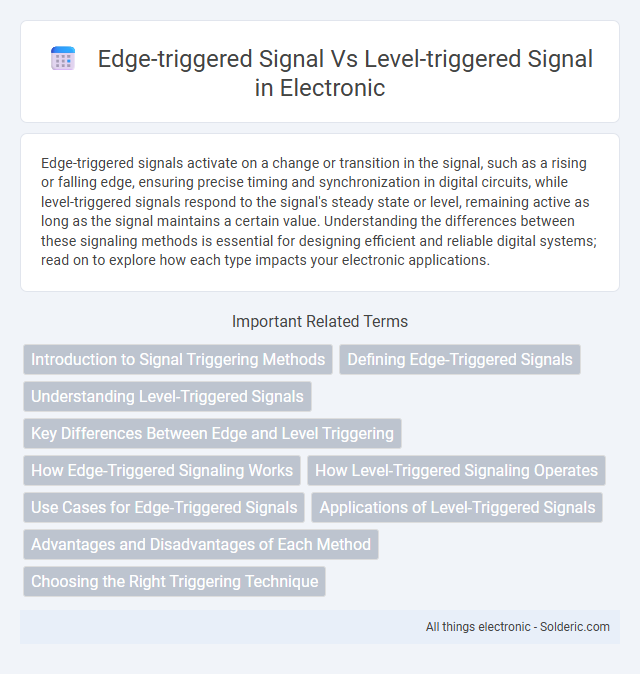Edge-triggered signals activate on a change or transition in the signal, such as a rising or falling edge, ensuring precise timing and synchronization in digital circuits, while level-triggered signals respond to the signal's steady state or level, remaining active as long as the signal maintains a certain value. Understanding the differences between these signaling methods is essential for designing efficient and reliable digital systems; read on to explore how each type impacts your electronic applications.
Comparison Table
| Feature | Edge-Triggered Signal | Level-Triggered Signal |
|---|---|---|
| Activation | Activates on signal transition (rising or falling edge). | Activates while the signal remains at a specific level (high or low). |
| Timing Sensitivity | Sensitive to precise timing of signal changes. | Insensitive to signal transitions; only depends on level duration. |
| Typical Use | Registers, flip-flops, clock signals in digital circuits. | Level-sensitive latches, control signals in hardware logic. |
| Signal Duration | Momentary during the transition (pulse). | Prolonged as long as the signal level is maintained. |
| Noise Susceptibility | Less prone to noise-induced errors due to brief activation. | More vulnerable to noise since it responds to steady levels. |
| Complexity | Generally more complex to implement and troubleshoot. | Simpler design but potentially slower response. |
Introduction to Signal Triggering Methods
Edge-triggered signals respond to changes in signal voltage at specific transition points, such as rising or falling edges, enabling precise timing control in digital circuits. Level-triggered signals activate when the input signal maintains a particular voltage level, either high or low, influencing circuit states continuously during that level. Understanding these triggering methods helps you design and troubleshoot timing-sensitive hardware systems effectively.
Defining Edge-Triggered Signals
Edge-triggered signals respond to changes in voltage levels by detecting transitions such as rising or falling edges, rather than continuous voltage levels like level-triggered signals. These signals capture data precisely at the moment the input changes, typically used in clocked digital circuits to synchronize operations. Understanding edge-triggered signals helps you design systems with accurate timing control and improved noise immunity.
Understanding Level-Triggered Signals
Level-triggered signals remain active as long as the input maintains a specific voltage level, enabling continuous data flow during that period. Your system interprets the signal state based on whether the voltage is high or low, allowing easier synchronization with asynchronous inputs. This characteristic contrasts with edge-triggered signals, which respond only to transitions, making level-triggered signals ideal for stable and prolonged data monitoring tasks.
Key Differences Between Edge and Level Triggering
Edge-triggered signals respond to changes in the signal's state, typically triggering on the rising or falling edge, enabling precise timing control in digital circuits. Level-triggered signals activate whenever the signal remains at a specific level (high or low), maintaining the output as long as the input level persists. Understanding these key differences helps you select the appropriate triggering method for applications requiring either transient event detection or sustained signal activation.
How Edge-Triggered Signaling Works
Edge-triggered signaling detects changes at the transition points of a signal, either rising or falling edges, rather than the signal's steady state level. This method captures data precisely at the moment the signal changes, reducing the risk of multiple triggering and ensuring synchronization in digital circuits. You benefit from accurate timing and improved noise immunity when employing edge-triggered designs in your signal processing applications.
How Level-Triggered Signaling Operates
Level-triggered signaling operates by continuously monitoring the signal voltage level, activating the circuit whenever the signal maintains a specific high or low state. This method ensures consistent response as long as the predefined voltage threshold is met, enabling reliable data transmission or control during the signal's stable phase. Your system benefits from predictable timing and simpler hardware design due to the persistent nature of level-triggered signals.
Use Cases for Edge-Triggered Signals
Edge-triggered signals are widely used in digital circuits for applications requiring precise timing, such as clocked flip-flops in synchronous systems where state changes occur only at signal transitions. They are essential in microprocessors and memory devices to avoid glitches and ensure data integrity during rapid signal changes. Edge-triggered designs improve reliability in event-driven systems like counters and event detectors by responding exclusively to rising or falling edges.
Applications of Level-Triggered Signals
Level-triggered signals are commonly used in applications requiring continuous monitoring of input states, such as in debounce circuits for mechanical switches and in memory latch designs that store data while a control signal remains active. They are integral to digital communication protocols like I2C, where signals must be held steady to ensure accurate data transfer. Industrial automation systems frequently employ level-triggered signals for sensor reading and process control, ensuring reliable operation under varying environmental conditions.
Advantages and Disadvantages of Each Method
Edge-triggered signals provide precise timing control by responding only to signal transitions, minimizing the risk of multiple activations and improving synchronization in high-speed digital circuits. However, they can be more complex to design and may require careful handling to avoid missing signal changes during a clock cycle. Level-triggered signals are simpler and more intuitive, maintaining output as long as the input level is active, but they risk unintended repeated activations if the input remains stable, potentially causing glitches or race conditions in your system.
Choosing the Right Triggering Technique
Edge-triggered signals activate on signal transitions, providing precise timing for synchronous circuits, making them ideal for clocked systems requiring accurate data capture. Level-triggered signals respond to sustained signal levels, enabling asynchronous designs that rely on the state rather than changes, suitable for transparent latches and simpler control logic. Selecting the right triggering technique depends on the application's timing requirements, with edge-triggered preferred for avoiding glitches and level-triggered useful for ease of implementation and continuous monitoring.
edge-triggered signal vs level-triggered signal Infographic

 solderic.com
solderic.com